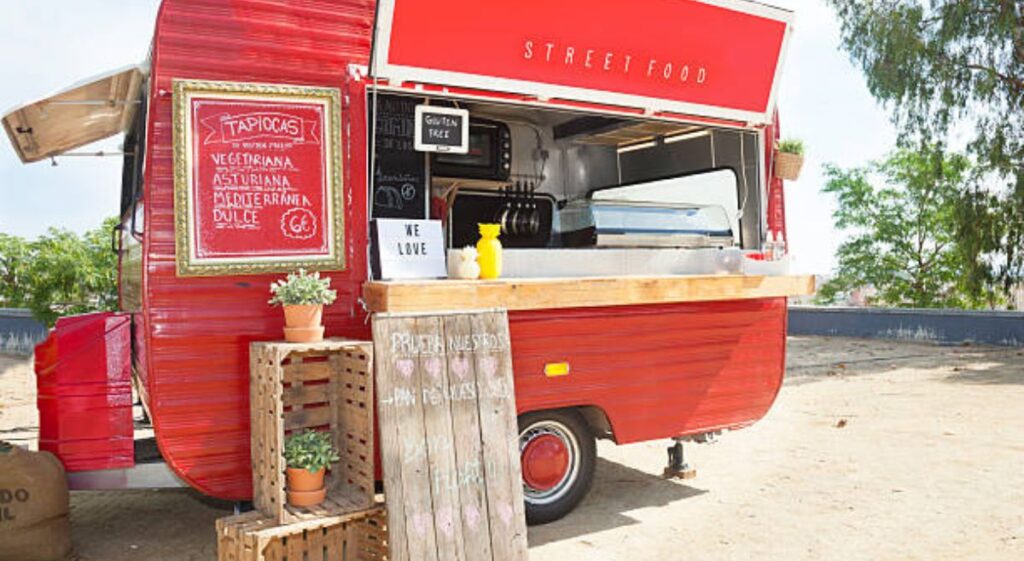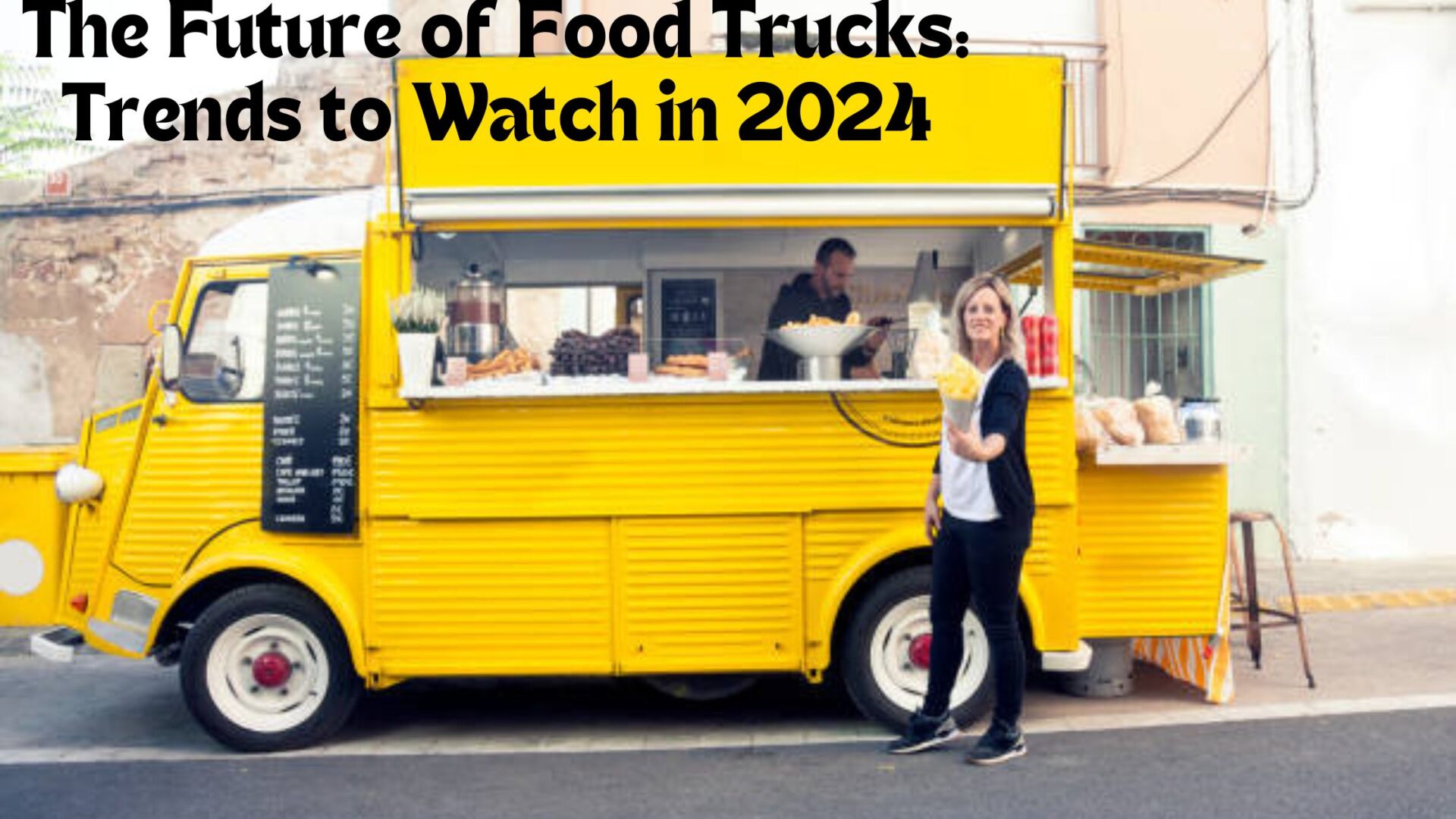Introduction
The Future of Food Trucks: Trends to Watch in 2024

In the evolving landscape of the food industry, food trucks have transformed from novelty vendors to essential culinary hotspots. As we enter 2024, numerous trends are shaping the future of this dynamic sector, ranging from technological advancements to sustainability efforts.
The Future of Food Trucks
1. Tech-Driven Operations:
Technology continues to revolutionize food truck operations, with many embracing advanced point-of-sale systems for streamlined orders, inventory management, and detailed sales analytics. Mobile apps and online ordering platforms further enhance customer convenience, reducing wait times and improving satisfaction.
2. Sustainability and Eco-Consciousness:
Sustainability is no longer a mere buzzword but a vital aspect of food truck operations. Many trucks are adopting eco-friendly practices, such as biodegradable packaging, locally sourced ingredients, and energy-efficient appliances. These actions not only reduce the carbon footprint but also resonate with environmentally conscious consumers.
3. Health-Conscious Menus:
Recognizing the growing demand for healthier options, food trucks are expanding their menus to include plant-based and vegan dishes. Gluten-free and keto-friendly meals cater to specific dietary needs, making food trucks inclusive dining destinations for a broader audience.
4. Fusion Cuisines and Unique Flavors:
Experimentation and creativity remain hallmarks of food trucks. In 2024, fusion cuisines will dominate the scene, blending elements from different culinary traditions to create innovative dishes. Korean-Mexican tacos and Indian-Italian pizzas exemplify this trend, offering unexpected and exciting flavor combinations.
5. Pop-Up Collaborations and Events:
Food trucks are increasingly collaborating with local businesses, breweries, and community events through pop-up events. These partnerships increase visibility and provide unique dining experiences for customers. Expect more food trucks teaming up for special events, offering limited-time menus, and generating buzz within their communities.
6. Enhanced Customer Engagement:
Social media platforms have become essential for food trucks to engage with customers. Instagram, TikTok, and Facebook are utilized to share behind-the-scenes content, promote new menu items, and interact with followers. Engaging storytelling and regular updates help build a loyal customer base and keep food trucks top-of-mind.
7. Focus on Quality and Authenticity:
As the food truck industry matures, consumers demand authentic, high-quality dishes. Food trucks are responding by sourcing the best ingredients, perfecting recipes, and delivering a consistent dining experience. Authenticity, combined with excellent service, becomes a key differentiator in a competitive market.
8. Food Truck Hubs and Markets:
Dedicated food truck hubs and markets are gaining popularity, offering a centralized location for multiple trucks to gather. These hubs provide a diverse culinary scene, attracting larger crowds and enhancing accessibility. Cities are expected to develop more spaces for food trucks, further solidifying their presence in the urban landscape.
Tailoring to Health-Conscious Consumers: How Food Trucks are Evolving
Food trucks have undergone a significant transformation to cater to the growing demand for healthier food options. Here are key ways they are adapting to meet the needs of health-conscious consumers:

1. Diverse and Nutritious Menu Options:
- Salads and Grain Bowls: Fresh, organic salads and grain bowls, often featuring a combination of vegetables, lean proteins, and wholesome grains like quinoa or brown rice, are increasingly popular.
- Smoothies and Juices: Smoothie and juice bars on wheels provide nutrient-rich beverages made from fresh fruits and vegetables.
- Plant-Based Foods: Vegan and vegetarian food trucks are on the rise, offering dishes such as veggie burgers, falafel wraps, and tofu entrees.
2. Sourcing Locally and Organically:
- Food trucks are emphasizing the use of locally sourced and organic ingredients to ensure quality, freshness, and support local farmers.
3. Gluten-Free and Allergen-Conscious Options:
- To accommodate dietary restrictions, many food trucks offer gluten-free breads, dairy-free products, and nut-free dishes, ensuring inclusivity for customers with allergies and preferences.
4. Nutritional Transparency:
- Health-conscious consumers appreciate the provision of detailed nutritional information for menu items, allowing them to make informed choices.
5. Customizable Meals:
- Food trucks enable customers to customize their meals by choosing specific ingredients, portion sizes, and cooking methods, catering to individual dietary needs and preferences.
6. Sustainable Practices:
- Environmentally conscious customers are drawn to food trucks that adopt sustainable practices such as biodegradable packaging, food waste reduction, and energy-efficient appliances.
7. Innovative Health-Focused Menus:
- Food trucks are experimenting with unique and innovative menu items that prioritize health, such as acai bowls, chia seed puddings, and kombucha drinks.
Examples of Health-Focused Food Trucks:
- The Green Radish: A vegan food truck serving locally sourced, organic plant-based dishes.
- Press. Gourmet Sandwiches: Specializing in sandwiches made with fresh, organic ingredients and gluten-free options.
- The Juicery: Known for its fresh-pressed juices, smoothies, and acai bowls made from organic fruits and vegetables.
Food trucks are rapidly adapting to meet the demands of health-conscious consumers, offering a diverse range of nutritious and customizable menu options. This evolution not only broadens their customer base but also promotes healthier eating habits within the community.
How do food trucks leverage social media to engage customers creatively and effectively?
Food trucks have harnessed the power of social media to enhance customer engagement in several innovative and impactful ways. Here are some key strategies they employ:

1. Real-Time Location Updates:
- Geo-Tagging and Check-Ins: Food trucks use platforms like Instagram, Twitter, and Facebook to update their locations in real-time, enabling customers to easily find them wherever they are.
- Daily Schedules: Posting daily or weekly schedules helps customers plan their visits and know when and where they can find their favorite food trucks.
2. Visual Content:
- Mouth-Watering Photos: High-quality photos of menu items attract customers by showcasing the food’s visual appeal and creativity.
- Behind-the-Scenes Content: Sharing videos or photos of food preparation and cooking processes creates a connection with the audience and builds trust.
3. Interactive Content:
- Polls and Surveys: Engaging followers through Instagram Stories or Twitter polls about menu preferences, new dish ideas, or feedback.
- Contests and Giveaways: Running contests where customers can win free meals or discounts by liking, sharing, or commenting on posts engages existing customers and attracts new followers.
4. User-Generated Content:
- Customer Photos and Reviews: Encouraging customers to share their own photos and reviews, which can then be reposted on the food truck’s social media accounts, builds community and adds authenticity.
- Hashtags: Creating and promoting specific hashtags for customers to use when posting about their experience with the food truck.
5. Storytelling and Brand Personality:
- Personal Stories: Sharing the story behind the food truck, its owners, and the inspiration for its menu creates a personal connection with customers.
- Consistent Branding: Using a consistent voice, style, and visual theme across all social media platforms helps build a recognizable and relatable brand.
6. Engaging with Followers:
- Responding to Comments and Messages: Actively engaging with followers by responding to their comments, questions, and direct messages fosters a sense of community and loyalty.
- Shoutouts and Features: Featuring loyal customers or collaborating with local influencers to reach a wider audience.
7. Promotions and Special Offers:
- Exclusive Deals: Offering special promotions, discounts, or secret menu items exclusively to social media followers.
- Event Announcements: Promoting upcoming events, special appearances, or collaborations through social media to create buzz and anticipation.
8. Educational Content:
- Recipe Sharing: Occasionally sharing recipes or cooking tips related to the food truck’s menu items.
- Nutritional Information: Providing nutritional information and health benefits of their dishes to appeal to health-conscious followers.
Examples of Effective Implementation:
- Kogi BBQ (Los Angeles): Pioneers in using Twitter for real-time location updates, engaging storytelling, and interacting with followers.
- The Cinnamon Snail (New York): Uses Instagram to showcase visually appealing vegan dishes, share behind-the-scenes content, and run engaging contests.
- Bacon Bacon (San Francisco): Engages followers with mouth-watering photos, customer shoutouts, and updates on their location and events.
By leveraging social media’s potential, food trucks enhance customer engagement, build a loyal fan base, attract new patrons, and create a vibrant online community around their brand.
Conclusion
In the culinary world, food trucks are destined for a radiant future, driven by groundbreaking trends that are reshaping the industry in captivating ways. From advanced technology-driven operations to eco-friendly initiatives and unparalleled culinary creations, food trucks are poised to maintain their position as pivotal players in the food industry. As 2024 unfolds, stay vigilant for these remarkable trends and seize every opportunity to immerse yourself in the vibrant and delectable realm of food trucks.
References
- “Food Trucks Continue to Thrive with Technology,” Food Truck Nation, January 2024.
- “Sustainable Practices in the Food Truck Industry,” Green Eats, March 2024.
- “The Rise of Health-Conscious Menus,” Healthy Living Magazine, April 2024.
- “Fusion Cuisines: The Future of Food Trucks,” Culinary Trends Journal, February 2024.
- “Engaging Customers Through Social Media,” Digital Marketing Insights, May 2024.








